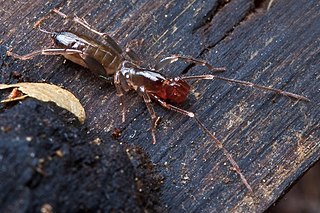
Schizomida, also known as sprickets or short-tailed whip-scorpions, is an order of arachnids, generally less than 5 millimetres (0.20 in) in length. The order is not yet widely studied. E. O. Wilson has identified schizomids as among the "groups of organisms that desperately need experts to work on them."
Draculoides bramstokeri is a small, troglobite, Australian arachnid. Often mistaken for a spider, D. bramstokeri is a schizomid — a small, soil-dwelling invertebrate that walks on six legs and uses two modified front legs as feelers. It uses large fang-like pedipalps, or pincers, to grasp invertebrate prey and crunch it into pieces before sucking out the juices. Named for this method of dispatching victims and after Bram Stoker, the author of Dracula.
Draculoides is a genus of troglobite schizomid arachnids endemic to North West Australia. Often mistaken for spiders, they are commonly known as short-tailed whip-scorpions or sprickets.
Attenuizomus cuttacutta is a species of schizomid arachnid in the Hubbardiidae family. It is endemic to Australia. It was described in 2000 by Australian arachnologist Mark Harvey. The specific epithet cuttacutta refers to the type locality.
Bamazomus bamaga is a species of schizomid arachnid in the Hubbardiidae family. It is endemic to Australia. It was described in 1992 by Australian arachnologist Mark Harvey. The specific epithet bamaga refers to the type locality.
Bamazomus subsolanus is a species of schizomid arachnid in the Hubbardiidae family. It is endemic to Australia. It was described in 2001 by Australian arachnologist Mark Harvey. The specific epithet subsolanus refers to the position of the type locality.
Bamazomus vespertinus is a species of schizomid arachnid in the Hubbardiidae family. It is endemic to Australia. It was described in 2001 by Australian arachnologist Mark Harvey. The specific epithet vespertinus refers to the position of the type locality.
Draculoides brooksi is a species of schizomid arachnid in the Hubbardiidae family. It is endemic to Australia. It was described in 2001 by Australian arachnologist Mark Harvey. The specific epithet brooksi honours Darren Brooks for his skills in collecting schizomids and other cave creatures.
Draculoides julianneae, also known as the Western Cape Range Draculoides, is a species of schizomid arachnids in the Hubbardiidae family. It is endemic to Australia. It was described in 2001 by Australian arachnologist Mark Harvey. The specific epithet julianneae honours Julianne Waldock for her efforts in collecting schizomids.
Draculoides vinei is a species of schizomid arachnids in the Hubbardiidae family. It is endemic to Australia. It was described in 1988 by Australian arachnologist Mark Harvey. The specific epithet vinei honours Brian Vine, a student of the species’ biology.
Draculoides anachoretus is a species of schizomid arachnids in the Hubbardiidae family. It is endemic to Australia. It was described in 2008 by Australian arachnologists Mark Harvey, Oliver Berry, Karen Edward and Garth Humphreys. The specific epithet anachoretus, from Greek anachoretes, refers to the species’ subterranean habitat.
Draculoides kryptus is a species of schizomid arachnids in the Hubbardiidae family. It is endemic to Australia. It was described in 2008 by Australian arachnologists Mark Harvey, Oliver Berry, Karen Edward and Garth Humphreys. The specific epithet kryptus, from Greek kryptos (‘hidden’), refers to the species’ subterranean habitat.
Draculoides immortalis is a species of schizomid arachnids in the Hubbardiidae family. It is endemic to Australia. It was described in 2020 by Australian arachnologists Kym Abrams and Mark Harvey.
Draculoides karenbassettae is a species of schizomid arachnids in the Hubbardiidae family. It is endemic to Australia. It was described in 2020 by Australian arachnologists Kym Abrams and Mark Harvey.
Draculoides noctigrassator is a species of schizomid arachnids in the Hubbardiidae family. It is endemic to Australia. It was described in 2020 by Australian arachnologists Kym Abrams and Mark Harvey.
Draculoides nosferatu is a species of schizomid arachnids in the Hubbardiidae family. It is endemic to Australia. It was described in 2020 by Australian arachnologists Kym Abrams and Mark Harvey.
Draculoides piscivultus is a species of schizomid arachnids in the Hubbardiidae family. It is endemic to Australia. It was described in 2020 by Australian arachnologists Kym Abrams and Mark Harvey.
Draculoides warramboo is a species of schizomid arachnids in the Hubbardiidae family. It is endemic to Australia. It was described in 2020 by Australian arachnologists Kym Abrams and Mark Harvey.
Notozomus curiosus is a species of schizomid arachnid in the Hubbardiidae family. It is endemic to Australia. It was described in 2000 by Australian arachnologist Mark Harvey. The specific epithet curiosus refers to the uncertain generic position of this unusual species.
Notozomus faustus is a species of schizomid arachnid in the Hubbardiidae family. It is endemic to Australia. It was described in 2000 by Australian arachnologist Mark Harvey. The specific epithet faustus refers to the luck involved in collecting this small species.
